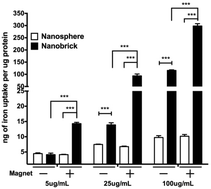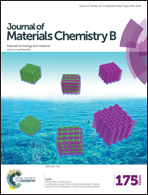Differential internalization of brick shaped iron oxide nanoparticles by endothelial cells†
Abstract
Nanoparticles targeting endothelial cells to treat diseases such as cancer, oxidative stress, and inflammation have traditionally relied on ligand–receptor based delivery. The present studies examined the influence of nanoparticle shape in regulating preferential uptake of nanoparticles in endothelial cells. Spherical and brick shaped iron oxide nanoparticles (IONPs) were synthesized with identical negatively charged surface coating. The nanobricks showed a significantly greater uptake profile in endothelial cells compared to nanospheres. Application of an external magnetic field significantly enhanced the uptake of nanobricks but not nanospheres. Transmission electron microscopy revealed differential internalization of nanobricks in endothelial cells compared to epithelial cells. Given the reduced uptake of nanobricks in endothelial cells treated with caveolin inhibitors, the increased expression of caveolin-1 in endothelial cells compared to epithelial cells, and the ability of IONP nanobricks to interfere with caveolae-mediated endocytosis process, a caveolae-mediated pathway is proposed as the mechanism for differential internalization of nanobricks in endothelial cells.


 Please wait while we load your content...
Please wait while we load your content...